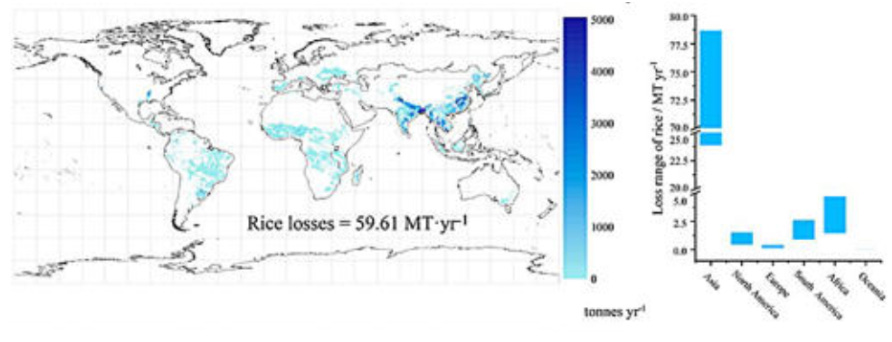Yesterday we had another hugely important story that the mainstream media skipped over so quickly you’d only have to blink once to miss it.
Last month, I reported on research evidence that frightening levels of microplastics are accumulating in human brains. Now the other shoe has dropped.
A new meta-study out of China looks at “how microplastics hinder photosynthesis across a wide range of plant species—including crucial food crops.” The study found that microplastics “result in approximately 4% to 14% harvest yield losses of maize, wheat and rice around the globe.” Furthermore, “the problem appears to be worsening, which will impact crop production even more.”
Global food supplies are already stretched thin. If the human population continues to grow at almost one percent per year, and microplastics knock perhaps one percent per year off global food production, mass starvation could well be on the cards.
Or perhaps not. In addition to the brain, microplastics tend to accumulate disproportionately in the sex organs, and in the plaque in cardiac arteries. If we’re ‘lucky,’ perhaps a decline in fertility, combined with an increase in heart attack deaths will mean that the human population falls in tandem with its food supply. (How’s that for squeezing a very small amount of lemonade out of a very big lemon!)
This study is saying that the plants we eat now contain enough microplastics to damage those plants.
You can filter the air in your house. You can filter your water. You can’t filter your food. The organic chia seeds, the organic broccoli, the organic blueberries you eat for their immune-boosting micro-nutrients - they all now come with a side-order of microplastics.
I’d like to add one last factor to the discussion. The study on microplastics in the brain found that the level of microplastics found in the autopsied brains did not change with the age of the deceased. The fact that older brains did not contain more microplastics would tend to indicate that the problem of microplastics in the environment is relatively recent in origin.
My guess is that discarded plastic bags, bottles and containers break down on an exponential curve - releasing only a tiny amount of microplastics in the first decade, modest amounts in the second decade, large quantities in the third decade, and massive amounts thereafter.
I suspect the microplastics we’re currently seeing in the environment are mostly from the 200 billion or so plastic bags, bottles and containers that were discarded before 1995. That would mean that the roughly six hundred billion plastic bags, bottles, and containers discarded since 1995 are still in the decay pipeline. If that is the case, the problem of microplastics in the environment will get much, much worse in years to come.
Our best current estimate is that, if your brain is an average human brain, it now contains the equivalent of a plastic spoon in microplastics, and the amount of microplastics in your brain will increase by roughly six percent per year. When/if your brain accumulates the equivalent of a plastic cutlery set of knife, fork, and spoon in microplastics, microplastics will likely cease to be a problem for you because you’ll be too senile to notice or care.
When I think of all the dystopian futures science fiction writers have created, it is the comedy satire Idiocracy - a future where the entire population is moronically stupid - that may come closest to the mark. It seems well within the realm of possibility that the undoing of our species may not be Terminator robots, alien invasion or nuclear Armageddon. Just myriads of plastic bags and bottles carelessly thrown away. Apparently God has a wicked sense of irony.
The poet T.S. Elliott predicted this exactly one hundred years ago:
This is the way the world ends
This is the way the world ends
This is the way the world ends
Not with a bang but a whimper.
Though the situation is dire, I think it is too early to give up hope. For all we know, there are activities, nutrients and/or medications that encourage the human brain to shed at least part of its accumulated load of microplastics.
I suspect that cleansing the oceans, rivers and lakes of their accumulated plastic debris would considerably slow the creation of new microplastics. And banning plastic containers, however expensive or inconvenient that might be, is long overdue.
Though I am not yet willing to be a guinea pig in an experiment to have those new plastic-eating bacteria injected into my brain, I could well change my mind if I start forgetting the names of my children.
Even if I had better data how much of the microplastics entering my body are sourced in the air I breathe, the water I drink, my favourite nylon sweater, the foods I eat - and which particular foods - I would at least have some ability to reduce those toxic inputs. Perhaps enough to put off D-for-Dementia Day for several more years.
I suspect that whatever Donald Trump says or does today will get at least 10,000 times as many column-inches of media coverage as this study on microplastics in the food supply does. The media might as well be shouting at full volume: Donald Trump is important; microplastics are not.
In truth, so long as Donald Trump manages to avoid stumbling into World War 3, nothing that Mr Trump says or does in the next four years will have as much impact on your personal future, on America’s future, or humanity’s future as a continuing increase in microplastics in the human brain will.
In a rational world, hundreds of thousands of scientists and engineers would right now be trying to better understand the problem of microplastics and/or exploring possible solutions. It’s that important.
We need to stop living in denial. There are probably a hundred ways we could begin addressing this issue, but first we need to acknowledge the gravity of the threat we’re facing.




